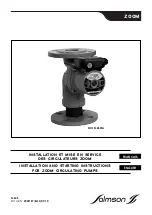
Installation & Operation Manual
27
2
Venting
(continued)
E
This option uses sealed AL29-4C vent materials for the flue outlet piping and separate combustion air inlet piping.
This system terminates both the flue and combustion air inlet in the same pressure zone. The flue outlet and
combustion air intake may terminate at either a sidewall or the rooftop.
To use the optional Direct Vent system, you must install specific vent kits and venting materials. The following is
a detailed explanation of Direct Vent installation requirements, including the components used and vent kit part
numbers (reference Table 2E on page 28 for kit numbers).
Flue outlet piping
Venting Guidelines
If using this venting option, a sealed AL29-4C venting system for flue products is required on all models of this
appliance. This venting system operates with a positive pressure in the vent. The internal combustion air blower
generates this positive pressure which operates the combustion process and also exhausts the flue products from the
building.
This vent system has specific vent material and installation requirements. Only use listed sealed AL29-4C vent system
materials. Follow all installation requirements. See Table 2A, page 16 for proper pipe size for your unit.
Seal all vent joints and seams gas-tight
.
NOTICE
Before installing a venting system, follow all requirements found in the General Venting section.
Direct Vent/Sealed Combustion
- see page 15.
Drain tee installation
A drain tee must be installed in the vent pipe to collect and dispose of any condensate that may occur in the vent system. The drain
tee must be installed as the first fitting after the horizontal ell on the top of the unit (see FIG. 2-9 on page 24). Plastic drain tubing,
sized per the vent manufacturer’s instructions, shall be provided as a drain line from the tee. The drain tubing must have a trap
provided by a 3" (7.6cm) diameter circular trap loop in the drain tubing. Prime the trap loop by pouring a small quantity of water
into the drain hose before assembly to the vent. Secure the trap loop in position with nylon wire ties. Use caution not to collapse
or restrict the condensate drain line with the nylon wire ties. The condensate drain must be routed to a suitable drain for disposal
of condensate that may occur in the direct vent system. Refer to the condensate drain installation instructions as supplied by the
manufacturer of the vent material.
WARNING
Do not combine the flue from this unit with the vent from any other appliance. Do not combine flues from
multiple appliances into a common vent. The flue from this unit must be a dedicated stack.
Connect the flue vent directly to the flue outlet opening on the top of the unit. Make the connections from the unit vent to the
outside stack as direct as possible with no reduction in diameter. Provide adequate clearance to combustibles for the vent connector
and firestop. Follow the vent manufacturer’s instructions when installing sealed AL29-4C vents and accessories, such as firestop
spacers, vent connectors, thimbles, caps, etc.
Provide adequate clearance to combustibles for the vent connector and firestop.
When planning the venting system, avoid possible contact with plumbing or electrical wiring inside walls, ceilings, and floors.
Locate the unit as close as possible to chimney or gas vent.
When a vent system is disconnected for any reason, the flue must be reassembled and resealed according to the vent manufacturer’s
instructions.
The installed length of flue from the unit to the outside point of termination must not exceed 50 equivalent feet (15.2m). Subtract
5 feet (1.5m) of equivalent length for each 90° elbow. Subtract 2.5 feet (0.7m) of equivalent length for each 45° elbow.
Vertical DV venting termination
You must use the vent termination recommended by the vent manufacturer for vertical direct vent terminations. Follow all vertical
venting termination information for clearances and location under the Vertical Vent Termination Clearances and Location section
on pages 18 - 19.
IMG00585
12"
MIN
3'
MIN
















































